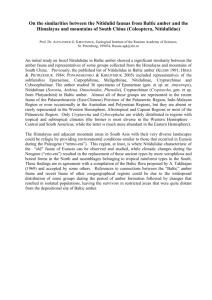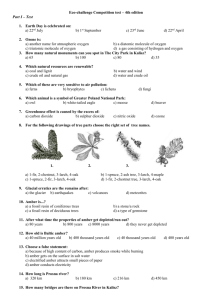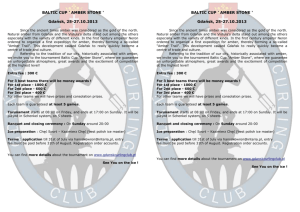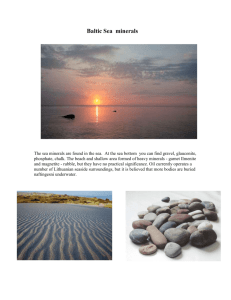in three pieces of Baltic amber
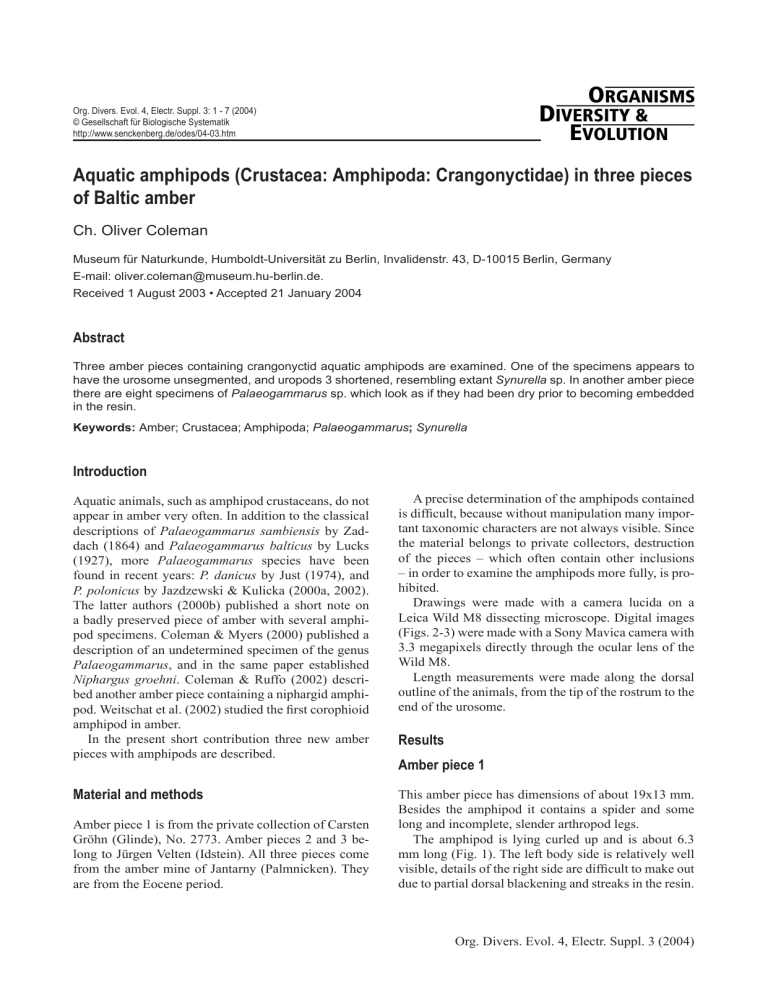
Coleman: Aquatic amphipods (Crustacea: Crangonyctidae) in Baltic amber 1
Org. Divers. Evol. 4, Electr. Suppl. 3: 1 - 7 (2004)
© Gesellschaft für Biologische Systematik http://www.senckenberg.de/odes/04-03.htm
Aquatic amphipods (Crustacea: Amphipoda: Crangonyctidae) in three pieces of Baltic amber
Ch. Oliver Coleman
Museum für Naturkunde, Humboldt-Universität zu Berlin, Invalidenstr. 43, D-10015 Berlin, Germany
E-mail: oliver.coleman@museum.hu-berlin.de.
Received 1 August 2003 • Accepted 21 January 2004
Abstract
Three amber pieces containing crangonyctid aquatic amphipods are examined. One of the specimens appears to have the urosome unsegmented, and uropods 3 shortened, resembling extant Synurella sp. In another amber piece there are eight specimens of Palaeogammarus sp. which look as if they had been dry prior to becoming embedded in the resin.
Keywords: Amber; Crustacea; Amphipoda; Palaeogammarus ; Synurella
Introduction
Aquatic animals, such as amphipod crustaceans, do not appear in amber very often. In addition to the classical descriptions of Palaeogammarus sambiensis by Zaddach (1864) and Palaeogammarus balticus by Lucks
(1927), more Palaeogammarus species have been found in recent years: P. danicus by Just (1974), and
P. polonicus by Jazdzewski & Kulicka (2000a, 2002).
The latter authors (2000b) published a short note on a badly preserved piece of amber with several amphipod specimens. Coleman & Myers (2000) published a description of an undetermined specimen of the genus
Palaeogammarus , and in the same paper established
Niphargus groehni . Coleman & Ruffo (2002) described another amber piece containing a niphargid amphipod. Weitschat et al. (2002) studied the first corophioid amphipod in amber.
In the present short contribution three new amber pieces with amphipods are described.
Material and methods
Amber piece 1 is from the private collection of Carsten
Gröhn (Glinde), No. 2773. Amber pieces 2 and 3 belong to Jürgen Velten (Idstein). All three pieces come from the amber mine of Jantarny (Palmnicken). They are from the Eocene period.
A precise determination of the amphipods contained is difficult, because without manipulation many important taxonomic characters are not always visible. Since the material belongs to private collectors, destruction of the pieces – which often contain other inclusions
– in order to examine the amphipods more fully, is prohibited.
Drawings were made with a camera lucida on a
Leica Wild M8 dissecting microscope. Digital images
(Figs. 2-3) were made with a Sony Mavica camera with
3.3 megapixels directly through the ocular lens of the
Wild M8.
Length measurements were made along the dorsal outline of the animals, from the tip of the rostrum to the end of the urosome.
Results
Amber piece 1
This amber piece has dimensions of about 19x13 mm.
Besides the amphipod it contains a spider and some long and incomplete, slender arthropod legs.
The amphipod is lying curled up and is about 6.3 mm long (Fig. 1). The left body side is relatively well visible, details of the right side are difficult to make out due to partial dorsal blackening and streaks in the resin.
Org. Divers. Evol. 4, Electr. Suppl. 3 (2004)
Coleman: Aquatic amphipods (Crustacea: Crangonyctidae) in Baltic amber
The cuticle of the specimen is thin and rather transparent, there are no muscles or organs visible inside the body. The cuticle appears to carry some microtrichs.
The left body side is clearly visible except for dense white clouding proximal of coxae 4-5. The urosome is also somewhat difficult to see due to the convexity of the nearby margin of the amber piece.
Description . Head rather large; no eyes visible, but on the left face there is a small oval patch below the cuticle where the eye is usually situated; rostrum short and weakly curved; anteroventral margin of head lobate, no excavation on ventral side of head.
Pereonite 2 shorter than 1 or 3. Posteroventral regions of tergites 1-4 rounded, those of tergites 5-7 subacutely angular. Epimera 1-3 with acutely produced posteroventral angles, ridges on the lateral faces of plates 1-2; ventral epimeral margins without setation, but some microtrichs on the posterior margins of plates
2-3. Urosomites 1-3 seem to be completely fused, no traces of segmental margins (artifact?).
Antenna 1 much longer than antenna 2, flagella of both antennae 1 curled up on right body side; peduncle article 1 stout, slightly longer than article 2; article 3 less than half the length of article 1. Antenna 2 articles
1 and 2 about subequal in length; droplet or air bubble at the tip of the gland cone of article 2; article 3 short; article 4 about 3 times as long as article 3. Mouthparts hidden behind the massive propodites of gnathopods
1-2 and proximal part of antenna 2; part of 3rd article of mandibular palp visible. Pereopod 1-3 coxae with straight anterior margins and rounded distal margins, the latter with slender setae directed laterally. Pereopod
4 coxa slightly longer than 3, with weakly convex anterior margin, distal margin rounded, posterior margin drawn out into lobe with slender marginal setae. Pereopod 5 coxa posteriorly rounded (anterior part not visible), ventrally lobate, with posteroventral notch with short slender seta; ridge on coxal face close to anteroventral margin; basis convexly rounded with weakly serrate margin, drawn out ventrally, with a microtrich in every excavation; ischium short with straight anterior and excavate posterior margin; merus with straight anterior and rounded posterior margin, distal margin oblique, merus shorter than carpus; carpus slender, subrectangular. Pereopod 6 coxa anterior part hidden behind posterior lobe of coxa 5, posterior lobe similar to that of pereopod 5 but more expanded posteriorly; basis with serrate posterior margin, ischium to carpus similar in shape to that of pereopod 5, but longer. Coxa
7 short with small notch posteromarginally; basis of similar shape as those of preceding appendages, but somewhat longer; merus and carpus shorter compared to pereopod 5. Pleopods normal as far as visible. Uropod
1 peduncle longer than rami, outer ramus somewhat shorter than inner. Peduncle of uropod 2 about half the length of that of uropod 1, rami subequal in length to peduncle. Uropod 3 peduncle short, ramus curved medially, situated on ventral face of telson. Telson turned upwards in an acute angle along the dorsal side of the urosome, with terminal, spine-like setae posteriorly. It cannot be discerned whether the telson is incised.
Amber piece 2
This amber piece has dimensions of 38x22x15 mm
(Fig. 2a, b: arrows). Embedded in the amber are two amphipod crustaceans: one about 8 mm long, the other in worse condition and approximately 5 mm long.
Apart from the amphipods the amber piece contains eight Diptera.
The left body side of the larger amphipod specimen with a white cuticle is relatively well visible (Fig. 2c), but high magnification is not possible due to the convex surface of the amber piece. The right body side is only partly visible due to cloudings in the resin (Fig. 2d).
Description . Head bulky with strongly flexed rostrum; anterior and ventral margin of head continuously rounded; no traces of eyes. Peduncular article of antenna 1 about twice as long as article 2, article 3 subequal in length to article 2. Articles 4 and 5 of antenna 2 subequal. Pereonite 1 longer than 2; posteroventral regions of pereonites 1-4 rounded, those of 5-7 angular. Anterior margins of coxal plates 1-4 straight; their apices truncate with setae, anterodistal angles rounded; coxal plate 4 as long as wide, ventral and posterior margin as well as lateral face with some setae. Coxa 5 wider than long, about the width of coxa 4, bilobate, both lobes of equal length. Posterior margin of coxa 6 rounded, that of coxa 7 weakly excavate. Posterior margin of bases
5-7 convexly rounded and bordered with setae. Pleon segments 1-3 subequal in length; posterolateral margins of segments 1-2 rather straight, that of segment 3 excavate; epimeral plates 2 and 3 with pointed and weakly produced posteroventral angles. Urosomite 1 slightly longer than 2 and 3, which are subequal in length.
The smaller specimen with a brownish cuticle is only partly visible due to cracks and cloudings in the surrounding resin. However, it looks very similar to the larger specimen in those characters that could be compared.
Amber piece 3
2
This piece measures 23x10x5 mm. It is quite remarkable in that it contains eight amphipods, although three of
Org. Divers. Evol. 4, Electr. Suppl. 3 (2004)
Coleman: Aquatic amphipods (Crustacea: Crangonyctidae) in Baltic amber 3
Fig. 1.
Amphipod in amber piece 1, views of left body side. a. Microphotography (by Carsten Gröhn). b. Line drawing; scale bar 1 mm.
Org. Divers. Evol. 4, Electr. Suppl. 3 (2004)
Coleman: Aquatic amphipods (Crustacea: Crangonyctidae) in Baltic amber 4
Fig. 2.
Amber piece 2 with two specimens of Palaeogammarus sp. a, b. Different views of amber piece 2; arrows point to amphipods; scale bar 1 cm. c. Left body side of the larger amphipod specimen. d. Right body side of larger specimen. e. Smaller amphipod specimen.
Org. Divers. Evol. 4, Electr. Suppl. 3 (2004)
Coleman: Aquatic amphipods (Crustacea: Crangonyctidae) in Baltic amber 5
Fig. 3. Amber piece 3 with eight specimens of Palaeogammarus sp. a. Overview; scale bar 1 cm. b. Detail of middle section as seen in a. c. Amphipod showing strong signs of shrinkage prior to embedding, and air trapped below the cuticle. d. Two rows of urosome spines (arrow) on the very left specimen in Fig. 3a.
Org. Divers. Evol. 4, Electr. Suppl. 3 (2004)
Coleman: Aquatic amphipods (Crustacea: Crangonyctidae) in Baltic amber them are only fragments. All are poorly preserved, and it seems that they had dried or decayed prior to their enclosure by the resin, as some show strong signs of shrinkage and the cuticle of several specimens is reflecting light as if air is trapped inside their appendages and below the body cuticle. All specimens appear to belong to a single species.
Discussion
Species determinations from amber specimens are very difficult in most cases. The material may be only partly visible due to other inclusions or to cloudings in the resin, or it is simply not well preserved. Compared to recent material, fossils of course do not allow dissections and examination of details such as mouthparts at high magnification. Very often only single specimens are available, making estimates of variability within the species impossible. In the amber pieces examined here not all of the relevant characters of the amphipods were visible either, and identifications at species level are not possible.
The specimens in the examined amber pieces 2 and
3 very probably represent crangonyctid aquatic amphipods. They are similar to the published descriptions of
Palaeogammarus species (Zaddach 1864; Lucks 1927;
Just 1974; Coleman & Myers 2000; Jazdzewski &
Kulicka 2002). Their rounded anteroventral head lobe, the shapes and marginal setation of coxae 1-4 and bases 5-7, the shortened second antenna, and the rather straight posterior margins of pleonites 1-2 correspond to those of the four known Palaeogammarus species
(Zaddach 1864; Lucks 1927; Just 1974; Jazdzewski &
Kulicka 2002).
The anterior part of the amphipod from amber piece
1 closely resembles Palaeogammarus species. However, a segmentation of the urosome, which occurs in all
Palaeogammarus species, is not visible. It is not clear if the urosome segments are really fused, nor if this might be an artefact. An unsegmented urosome occurs in extant Synurella species, cf. Synurella ambulans (F.
Müller, 1846) in Schellenberg (1942). Also differing from Palaeogammarus species there are no rows of spines (cf. Fig. 3d, and Zaddach 1864: fig. 11) on the dorsal face of the urosome, and uropods 3 seem to be strongly reduced in size, consisting of a rather short peduncle and a minute ramus with some short terminal setae. The shortened uropods 3 are in contrast with all three Palaeogammarus species, which have quite long third uropods (compare, e.g., with Just 1974: fig. 1).
However, the uropod morphology of the specimen in amber piece 1 is similar to that of extant Synurella sp.
(see Schellenberg 1942: fig. 66B; Karaman 1974). Recent members of the genus Synurella occur in shallow waters in the temperate zone from northern Germany to the Pacific coast, from the northwestern Balkans to the polar sea and the west coast of Alaska. Occurrence in
Baltic amber may reflect a similar distribution millions of years ago, if indeed the specimen is a Synurella .
It is a mystery how aquatic animals could have been preserved in amber. Zaddach (1864) presumed that the amphipod he studied had been dry before it was trapped in the resin. Coleman & Myers (2000) found signs of shrinkage on the cuticle of Niphargus groehni . The specimens in amber piece 3 studied here were definitely dry before being enclosed by the resin. They show strong signs of shrinkage, and the typical silvery reflections caused by air below the cuticle. Jazdzewski &
Kulicka (2000b) described an amber piece containing about seven amphipod specimens, similar to amber piece 3 with eight specimens studied herein. They imagined a scenario of enclosure in which the amphipods were captured in a „quickly drying out micro-pool at the water line, as well as sudden covering of the halfdry crustaceans by the drops of resin falling from the neighbouring trees“. Another possibility would be that dried amphipods were blown into the resin by the wind.
Acknowledgements
6
The author thanks Mr. Carsten Gröhn and Mr. Jürgen
Velten for allowing examinations of their valuable material.
Org. Divers. Evol. 4, Electr. Suppl. 3 (2004)
Coleman: Aquatic amphipods (Crustacea: Crangonyctidae) in Baltic amber
References
Coleman, C.O., Myers, A.A., 2000. New Amphipoda from
Baltic amber. Pol. Arch. Hydrobiol. 47, 457–464.
Coleman, C.O., Ruffo, S., 2002. Another discovery of a niphargid amphipod (Crustacea) in Baltic amber. Mitt.
Geol.-Paläont. Inst. Univ. Hamburg 86, 239–244.
Jazdzewski, K., Kulicka, R., 2000a. Ein neuer Flohkrebs
(Crustacea) in Baltischem Bernstein. Fossilien 1, 24–26.
Jazdzewski, K., Kulicka, R., 2000b. A note on amphipod crustaceans in a piece of Baltic amber. Annls Zool. 50,
99–100.
Jazdzewski, K., Kulicka, R., 2002. New fossil amphipod,
Palaeogammarus polonicus n. sp., from the Baltic amber. Acta Geol. Polon. 3, 379–383.
Just, J., 1974. On Palaeogammarus Zaddach, 1864, with a description of a new species from western Baltic amber
(Crustacea, Amphipoda, Crangonyctidae). Steenstrupia
3, 93–99.
Karaman, G.S., 1974. Genus Synurella Wrzes. in Yugoslavia with remarks on its all world known species, their synonymy, bibliography and distribution (fam. Gammaridae). 58th contribution to the knowledge of the Amphipoda. Poljoprivreda i Sumarstvo 20, 83–133, 19 figs.
Lucks, R., 1927. Palaeogammarus balticus , nov. spec., ein neuer Gammaride aus dem Bernstein. Schr. naturforsch.
Ges. Danzig, N. F. 18, 1–13.
Schellenberg, A., 1942. 40. Teil. Krebstiere oder Crustacea.
IV: Flohkrebse oder Amphipoda, in: Dahl, F (Ed.), Die
Tierwelt Deutschlands und der angrenzenden Meeresteile nach ihren Merkmalen und nach ihrer Lebensweise.
Gustav Fischer, Jena, pp. 1–252.
Weitschat, W., Brandt., A., Coleman, C.O., Myers, A.A.,
Wichard, W., 2002. Taphocoenosis of an extraordinary arthropod community in Baltic amber. Mitt. Geol.-Paläont. Inst. Univ. Hamburg 86, 189–210.
Zaddach, G., 1864. Ein Amphipode im Bernstein. Schr.
Phys.-Ökon. Ges. Königsberg 5, 1–12.
7
Org. Divers. Evol. 4, Electr. Suppl. 3 (2004)

